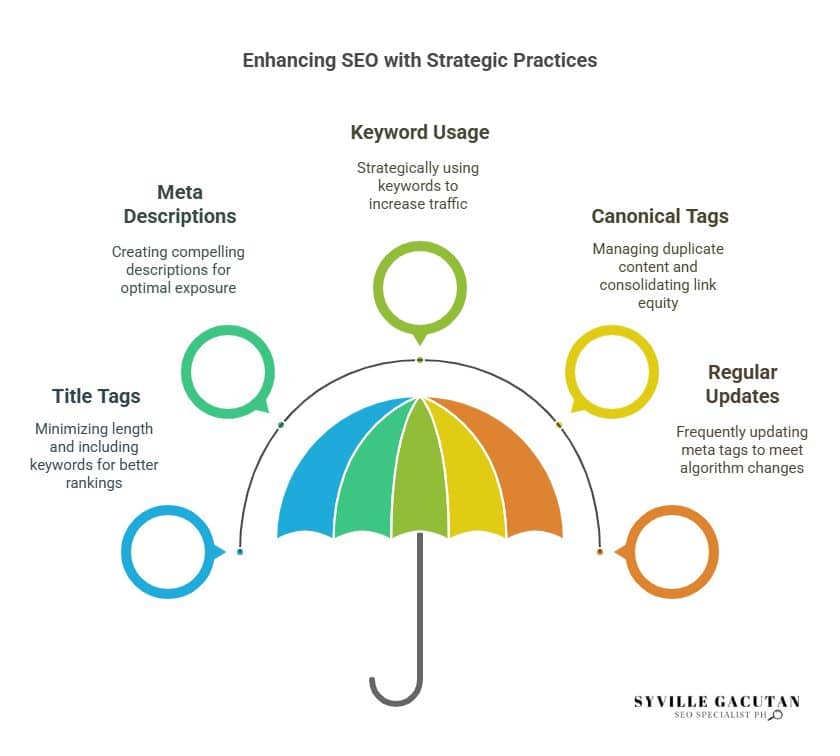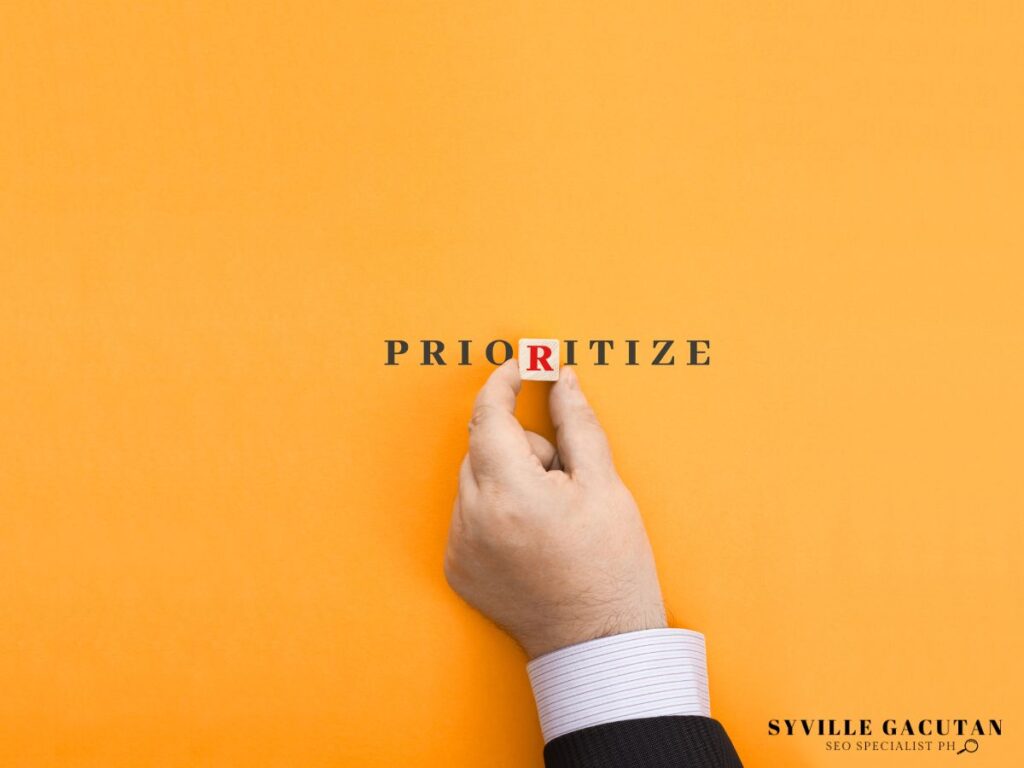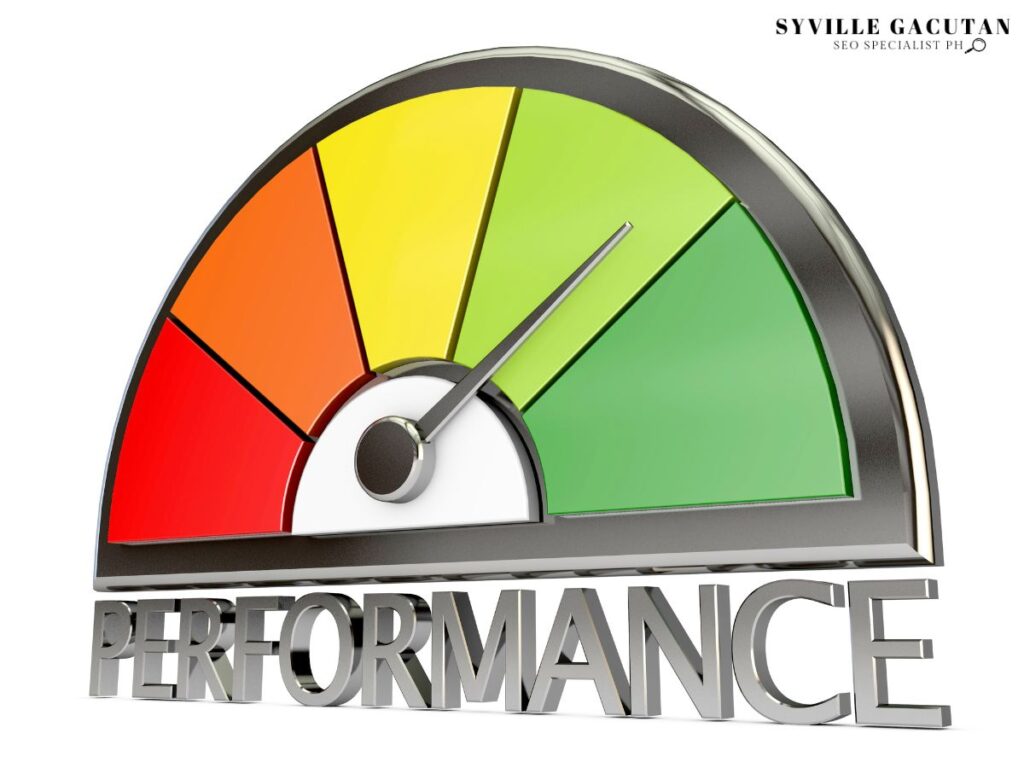
Top 10 Meta Tags Practices for Better Visibility
To enhance visibility, it’s crucial to focus on optimizing title tags and crafting engaging meta descriptions. Use relevant keywords strategically and ensure header tags are well-structured for improved indexing. Address duplicate content with canonical tags and avoid repetitive meta tags. Utilize noindex tags wisely to control search engine visibility of certain pages. Consistent monitoring of tag performance through metrics like CTR and bounce rates is vital. Keeping meta tags updated ensures alignment with the latest search algorithms. These best practices for meta tags SEO not only bolster but also refine user engagement and content discovery. Discover these strategies in further depth.
Key Takeaways
- For better search rankings, minimize title tags to 50–60 characters and include your main keywords at the top.
- Create audience-focused, emotionally compelling meta descriptions that are between 150 and 160 characters long for optimal exposure.
- To improve exposure and increase organic traffic, strategically use pertinent keywords in titles, meta tags, and content.
- Implement canonical tags to manage duplicate content, consolidating link equity and improving SEO.
- Update meta tags frequently to keep users interested and to conform to changing search engine algorithms.

1. Optimize Title Tags

Title tags are a critical element in search engine optimization, serving as the first impression for both users and search engines. They play a pivotal role in conveying the content’s relevance, impacting click-through rates and overall visibility. To optimize title tags effectively, attention must be paid to several key factors.
Firstly, title length is paramount. Ideally, title tags should be concise, generally keeping within 50-60 characters to ensure that they are fully displayed in search results.By doing this, the user experience is improved because users and search engines can understand the content’s core without it being truncated.
Keyword placement is another crucial aspect. Strategically placing primary keywords at the beginning of the title tag can significantly improve search engine ranking. However, it’s important to maintain a natural flow, avoiding keyword stuffing which can detract from readability and user engagement.
Incorporating unique branding within title tags can also differentiate your content from competitors. Including your brand name, especially at the end, can enhance recognition and build trust with users, fostering a sense of authority and reliability.
With the increasing prevalence of mobile searches, mobile optimization of title tags is indispensable. Mobile screens display fewer characters, making brevity and relevance even more critical. Ensuring that the most important information appears first can improve visibility on mobile devices.
2. Craft Engaging Meta Descriptions
Having laid the foundation for effective title tag optimization, the focus now shifts to crafting engaging meta descriptions. These brief yet potent snippets serve as the first impression of your content, making creative writing and emotional appeal essential tools. A well-crafted meta description not only informs but also entices potential visitors to click through to your site.
To achieve this, one must carefully consider audience targeting. Understanding the needs and desires of your target demographic allows you to tailor meta descriptions that resonate on a personal level. This connection can be enhanced through a strategic call to action, prompting users to take the next step, whether it’s learning more, exploring services, or purchasing a product.
When writing meta descriptions, it is crucial to adhere to character limits typically set at 150-160 characters. This ensures the entire description is visible in search engine results, maximizing its impact. With limited space, every word must count, delivering a concise and compelling message.
Consider these elements for crafting effective meta descriptions:
- Inspire curiosity: Use intriguing questions or statements that compel users to want to learn more.
- Promise value: Highlight what makes your content unique and beneficial to the reader.
- Evoke emotion: Tap into feelings that resonate with your audience, creating a sense of urgency or excitement.
3. Use Relevant Keywords

In the realm of search engine optimization, the strategic use of relevant keywords is paramount for enhancing visibility and driving organic traffic to your website. The foundation begins with comprehensive keyword research, which involves identifying terms and phrases that potential visitors are likely to use when searching for content related to your site. This research not only aids in understanding user intent but also helps in formulating a robust content strategy.
One key aspect of effective keyword utilization is the incorporation of long tail keywords. These are more specific phrases that often have lower search volumes but are typically less competitive and more targeted. By focusing on long tail keywords, you can attract a niche audience that is more likely to convert, thus maximizing the return on your SEO efforts.
Keyword placement is another crucial element. Strategically embedding keywords in meta tags, titles, and throughout your content ensures search engines recognize the relevance of your pages. However, it is essential to maintain a natural flow and avoid keyword stuffing, which can be detrimental to user experience and search rankings.
Conducting a competitive analysis can provide valuable insights into which keywords are successfully driving traffic to similar sites. This information can guide your keyword strategy and help identify opportunities to differentiate your content.
4. Prioritize Header Tags

Header tags play a critical role in structuring webpage content and enhancing SEO performance. By establishing a clear header hierarchy, you not only guide search engines in understanding the structure of your content but also improve user experience for visitors.
The importance of header hierarchy cannot be overstated, as it helps convey the main topics and subtopics of your page, making it easier for search engines to index your content effectively.
Effective tag nesting is another crucial aspect of utilizing header tags. Correctly nested tags ensure that your content maintains a logical flow, which is essential for semantic HTML benefits. This practice not only aids search engines in parsing your content efficiently but also enhances accessibility considerations, making your website more inclusive for users with disabilities.
- Clarity: Well-structured headers clarify content for both users and search engines, driving engagement.
- Empowerment: Users feel empowered when they can easily navigate and comprehend your web content.
- Trust: Properly optimized headers build trust, as they reflect a well-organized and authoritative website.
The impact of header tags extends to mobile optimization as well. With the increasing number of users accessing websites via mobile devices, ensuring your headers are optimized for smaller screens is crucial.
This approach not only enhances readability but also contributes to a more seamless user experience. Utilizing header tags effectively by paying attention to header hierarchy importance, effective tag nesting, and semantic HTML benefits will significantly improve your site’s SEO performance and accessibility.
5. Implement Canonical Tags

Canonical tags are a vital component for managing duplicate content issues on your website, ensuring that search engines recognize the preferred version of a webpage. By implementing rel=“canonical”, webmasters can guide search engines to the primary URL that should be indexed, consolidating link equity and preventing content dilution.
This practice is especially beneficial for e-commerce sites with similar product pages or blogs with syndication, where identical content might appear across multiple URLs.
The canonical tag benefits include improved search engine optimization (SEO), as it aids in the proper allocation of ranking signals to the main page. Additionally, it streamlines the crawling process for search engines, enhancing overall site visibility and performance.
However, these benefits can only be realized when canonical tags are implemented correctly.
Common canonical mistakes often involve pointing canonical tags to non-existent pages, using them on paginated content incorrectly, or setting self-referential canonical tags unnecessarily. Such errors can confuse search engines, leading to indexing issues and decreased site authority.
Utilizing canonical tag tools, such as Google’s Search Console and third-party SEO auditing software, can help diagnose and resolve these issues effectively.
Conducting an SEO impact analysis is crucial to understand the effects of canonical tags on your website’s search engine rankings. Regularly monitor your site’s performance to ensure the intended URLs are receiving the appropriate traffic and authority.
6. Leverage Alt Text for Images
Effective search engine optimization involves more than just managing URLs; it also requires optimizing on-page elements like images. A critical aspect of enhancing image accessibility and improving search rankings is the use of alt text.
Alt text, or alternative text, is a concise description of an image that informs both search engines and users about the content and function of the visual content. Properly crafted alt text not only supports SEO benefits but also ensures that all users, including those with visual impairments, can fully experience your website’s content.
When leveraging alt text for images, adhere to specific guidelines to maximize its effectiveness:
- Descriptive Accuracy: Ensure that the alt text accurately describes the image content. This aids both search engines and users in understanding the context.
- Keyword Integration: Where appropriate, incorporate relevant keywords to enhance search rankings. However, avoid keyword stuffing as it can lead to penalties.
- Simplicity and Clarity: Keep the text clear and concise, focusing on the essential elements of the image. Overly complex or lengthy descriptions may confuse rather than clarify.
7. Avoid Duplicate Meta Tags

In the realm of search engine optimization, avoiding duplicate meta tags is crucial for maintaining a website’s visibility and ranking. Duplicate meta tags can lead to confusion for search engines, impacting their ability to accurately index and rank web pages. This can result in the dilution of a site’s SEO efforts and introduce the risk of SEO penalties, such as lower search rankings.
Duplicate detection tools are essential in identifying these redundancies. By employing such tools, webmasters can efficiently scan their websites to uncover and rectify duplicate meta tags. This proactive approach not only prevents the adverse impact of duplicates on search engine rankings but also enhances user experience.
When users encounter multiple pages with identical meta descriptions or titles, it can create confusion and reduce the likelihood of them engaging with the content, leading to decreased traffic and conversions.
The impact of duplicates extends beyond search engine algorithms. It directly affects user experience, as repetitive content can appear unprofessional and diminish the perceived value of the website.
Therefore, adopting sound content management strategies is vital. This involves systematically organizing and updating meta tags to ensure uniqueness and relevance for each page.
8. Utilize Noindex Tags Wisely

Strategically implementing noindex tags can significantly enhance a website’s SEO strategy by controlling which pages search engines index and display in search results. This tactic allows webmasters to refine their content strategy and focus on pages that offer the most value to users, thereby improving user experience. The noindex tag is a powerful tool with several benefits, enabling precise indexing choices that align with the site’s overall goals.
When considering which pages to apply noindex tags, it is essential to understand the search engine implications. Pages with thin content, duplicate content, or those that do not contribute positively to user engagement can unnecessarily dilute the quality of indexed pages. By carefully selecting pages to exclude from indexing, you can ensure that search engines focus on the most relevant and valuable content.
Leverage the noindex tag to:
- Enhance user experience by directing visitors to high-quality, relevant pages.
- Improve site performance by reducing resource allocation to non-essential pages.
- Strengthen SEO efforts by maintaining a streamlined and focused index.
Implementing noindex tags requires a thoughtful approach. For example, while you may want to noindex internal search results or outdated pages, it’s crucial to maintain a balance. Overusing noindex tags can inadvertently hinder your site’s visibility and affect traffic.
Therefore, your content strategy should consider both noindex benefits and the potential drawbacks of excluding too many pages from indexing. Ultimately, the key lies in making informed indexing choices that align with your website’s objectives, ensuring that both search engines and users have access to the most valuable content.
9. Monitor Tag Performance

To truly maximize the benefits of meta tags, one must diligently monitor their performance. Monitoring involves an analytical approach to understanding how meta tags contribute to user engagement and search visibility. By leveraging tag analytics, website managers can gain insights into how effectively these tags are drawing traffic and retaining visitor attention.
Performance metrics such as click-through rates (CTR), bounce rates, and average time on page are pivotal in evaluating the efficacy of meta tags.
Incorporating A/B testing into the monitoring process can further refine meta tag strategies. This testing method allows for the comparison of different tag configurations to identify which versions yield better results. For instance, experimenting with variations in title tags or meta descriptions can reveal preferences that resonate more with users, thereby enhancing search visibility and engagement.
Through systematic analysis, one can discern patterns and make informed adjustments that align more closely with user behavior and search engine algorithms.
Effective monitoring also involves keeping an eye on external changes, such as updates in search engine algorithms, which can affect how tags are interpreted and ranked. Understanding these factors ensures that meta tags remain optimized for current search engine standards.
Moreover, by staying informed through tag analytics, one is better equipped to pivot strategies in response to shifts in user engagement trends.
10. Keep Tags Up-to-Date

Regularly updating meta tags is essential for maintaining optimal search visibility and user engagement. The meta tag importance cannot be overstated, as these small snippets of code play a significant role in how search engine algorithms interpret and rank your web pages.
Adhering to SEO best practices requires a proactive approach to keep these tags fresh and relevant. As search engines continually evolve, so must your tags, ensuring they align with current trends and updates.
The tag update frequency is a critical component of your SEO strategy. Here’s why keeping your meta tags up-to-date is imperative:
- Enhanced User Experience: Accurate and current meta tags provide users with relevant information, enticing them to click through to your site. An engaging and precise meta description can significantly enhance user experience by setting correct expectations.
- Adaptation to Algorithm Changes: Search engine algorithms are not static; they undergo frequent updates. By regularly revising your meta tags, you ensure that your site remains compliant with the latest algorithmic requirements, helping maintain or improve your ranking.
- Reflect Current Content: As your content evolves, so should your meta tags. Outdated tags may mislead users and search engines alike, leading to decreased visibility and engagement.
Final Thoughts
To boost your website’s visibility and improve SEO performance, focusing on meta tags is crucial. By optimizing title tags, crafting compelling meta descriptions, using relevant keywords, and implementing best practices such as canonical tags and noindex tags, you can enhance both user engagement and search engine rankings. Regularly monitoring performance and keeping tags updated ensures your site remains aligned with current search engine algorithms, helping you stay competitive and drive sustainable traffic growth.
Ready to elevate your website’s SEO with expertly optimized meta tags? Connect with Syville Gacutan, an experienced SEO Specialist in the Philippines. Syville can help you create powerful meta tags, refine your SEO strategy, and boost your site’s search visibility. Get in touch today and take your SEO to the next level!